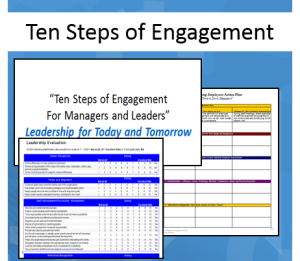Ten Steps of Engagement for Managers and Leaders
This is our flagship employee engagement workshop which has been delivered to participants in public workshops and within organizations globally. Based on the best-selling book, Louder than Words by Bob Kelleher, the workshop focuses on exercises, activities and tools that are proven to create a culture of engagement in any organization. Now you can implement this successful 1 – 2 day workshop in your organization. Not sure you can deliver yourself? Call about our Train the Trainer services (978-281-7258)!
Length: 8 – 16 hours
Venue: Classroom
What you get: You receive these complete, ready-to-use files in Microsoft Office formats:
- Ten Steps to Engagement for Managers and Leaders slide show – The Ten Steps to Engagement for Managers and Leaders workshop is the key training module to help the leaders in a company understand and apply the 10 steps of engagement. Click for a file of selected slides and facilitator notes.
- Engaged Leader Change Plan – Integrated into the workshop are periodic opportunities for participants to commit to change.
- Communication Protocol Overview and Template – The Communication Protocol provides the structure of how employees can expect to receive information – how much, how often, and from who.
- Twelve Needs a Leader Must Fill – A leader must wear many hats and fill many needs. This exercise provides a description of each of the 12 needs and an opportunity for self as well as team evaluation as to how well you are meeting employee needs.

- Learning and Development Strategies – Training is not the only way to learn and develop. This matrix-style tool provides ten learning and development strategies with benefits and implementation strategies. Click to download a sample
- Team Development Handout – As part of the team development aspect of the workshop and as an effective quick guide, this matrix document provides participants with an opportunity to implement team development best practices after the workshop.
- Generations at Work Quick Guide – Working with the different generations in the same business environment is a challenge. This quick guide provides a comparison and strategies for working with the different generations.
- Similarities of the Generations – Although all the generations in the workplace today have their differences, it’s their similarities that will bring them together. Creating an action plan capitalize on the similarities is the objective of this exercise. Click to download the exercise document
- Three Circles Model – In any work environment, there are tasks that must be completed (circle #1). In order to be fully engaged, the employee assigned to this task must be effective doing that task (circle #2) and want to do the task (circle #3). If these three circles do not exist, an employee will be disengaged.
- Seven Motivators Self-Assessment – The only person you can truly motivate is yourself. But that will be more difficult if you don’t know what your motivational drivers are. This self assessment will help to determine what motivates you.
- Seven Motivators Team Assessment – After determining your motivational drivers, see if you can determine what motivates your individual team members. After, take it to your team to evaluate how you did.
- Creating a Successful Balanced Scorecard – A balanced scorecard is an effective tool to both track business metrics as well as communicate to employees. This guide provides a roadmap to creating and maintaining a successful balanced scorecard. Click for a sample document
- Diversity Wheel and Exercise – The diversity model that most people are familiar with is based on the Equal Employment Opportunity Commission (EEOC) that protects race, gender, age, etc. The engagement diversity model maintains the EEOC model while adding multiple dimensions of diversity which leads to innovation.
- B.E.S.T. Profile – We hire based on experience and skills but often fire (or promote) based on behaviors and traits. Why not hire the behaviors and traits you want to promote? Click for a sample document
- Stay Interview Questions – Most organizations interview employees when they leave, looking for patterns and ways they might have retained those employees. The Stay Interview provides a model in which we conduct a similar interview before the employee considers leaving. Click for a sample document




